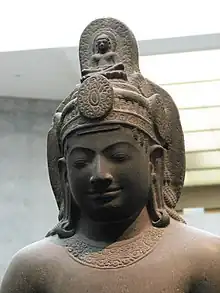เจ้าอยู่หัว
Thai

A 7th-century Cambodian sandstone sculpture of Avalokiteśvara the future buddha, with a buddha figure on his head.

A 13th-century Cambodian sculpture of Avalokiteśvara the future buddha, with a buddha figure on his head.
Etymology
From เจ้า (jâao, “chief, lord, master; god; priest; royal person; etc”) + อยู่ (yùu, “to be at, in, on, etc; to remain, to stay; etc”) + หัว (hǔua, “head”); literally meaning:
- (a) "lord above [all/our/my] head[s]",
- (b) "lord at [all/our/my] head[s]", or
- (c) "[one with] lord on the head".
The suggested meaning (c) is based on the traditional belief that a future Buddha has a figure of Lord Buddha upon his/her head.
Pronunciation
| Orthographic | เจ้าอยู่หัว e t͡ɕ ˆ ā ɒ y ū ˋ h ạ w | |
| Phonemic | จ้าว-หฺยู่-หัว t͡ɕ ˆ ā w – h ̥ y ū ˋ – h ạ w | |
| Romanization | Paiboon | jâao-yùu-hǔua |
| Royal Institute | chao-yu-hua | |
| (standard) IPA(key) | /t͡ɕaːw˥˩.juː˨˩.hua̯˩˩˦/(R) | |
Noun
เจ้าอยู่หัว • (jâao-yùu-hǔua)
- (พระ~, สมเด็จพระ~, พระบาทสมเด็จพระ~) an honorific for or term of address to a monarch, archaically applicable to high-ranking royal persons also.
Usage notes
Related terms
- เจ้าเหนือหัว
- พระพุทธเจ้าอยู่หัว
- พ่ออยู่หัว
- แม่อยู่หัว (mɛ̂ɛ-yùu-hǔua)
- เหนือหัว
- องค์เหนือหัว
This article is issued from Wiktionary. The text is licensed under Creative Commons - Attribution - Sharealike. Additional terms may apply for the media files.